Album Weeds – Barbados
English people have a very peculiar habit of insisting upon adding an E to the name of this island. I really do not remember ever having seen the name written in book, newspaper, or pamphlet, except of course, in the various philatelic publications, otherwise than “Barbadoes”; and even Mr. Pemberton’s Handbook will be found to have this same defect. However, my task is to describe stamp forgeries, and not English peculiarities, and I merely mention this en passant.
The Barbados stamps are rather difficult to arrange, and the varieties of paper, watermark, perforation, etc., are decidedly puzzling. There appear to me to have been several types, but I fancy that some of them are simply due to the wear and tear of the plates. Originally there was a cord or line round the center of the smaller chest or package beside Britannia, but after a time this disappears altogether bit by bit. Another type or “state” has the lines of engine-turning in the background set very much closer together, so that the vertical line of diamond-shaped dots to the left of the spear is not visible. These two types or “states” are found only on the stamps without value indicated. All those with BARBADOS at the top, and value at the bottom, even from the first unperforated Sixpence and One Shilling, are from the second state of the die, with the lines close together. The head-dress of Britannia is a helmet, with some animal (a lion?) couchant on the top of it, and two five-pointed stars below the animal. This is in the first state of the plate. The second state, with fine lines of engine-turning, shows only one of the stars (the one immediately over the right eye of Britannia), the other being obliterated. I have given this slight description of the types or states, as I do not remember having noticed any mention of them elsewhere.


 Issue of 1852. Value not indicated. Green, blue, red; on blued paper; unperforated.
Issue of 1856-57. Same type, on white paper; unperforated; green, blue.
Issue of 1852. Value not indicated. Green, blue, red; on blued paper; unperforated.
Issue of 1856-57. Same type, on white paper; unperforated; green, blue.
Genuine
Engraved in taille-douce, paper as above, no watermark, unperforated. Size of stamp, 21 3/4 x 18 1/2 mm. Britannia wears a helmet, as above described, with a lion on the top of it, and two five-pointed stars, or one star, according to the state of the plate, below the lion. The bordering at the top and sides of the stamp looks rather intricate at first sight; but it is not really so, being merely formed of little crescents, in white outline, intersecting each other. At the top there are eleven entire crescents, with a half- crescent at each end to fill up. On the left side there are fourteen entire crescents, with a three-quarter crescent to fill up, at the top and at the bottom. The right side is exactly the same as the left. The head of the spear is diamond-shaped, and one-half of the diamond is shaded. The eyebrows are very distinct, and so is the outline of the side of the nose. From the brooch on the shell-collar, down almost to the waist, there are several vertical lines of shading on the front of the dress, indicating folds. The ship is very nicely done, and represents a three-master, square-rigged, with a long pennant, which streams out so as almost to touch the arm of Britannia. The hair on the right side of the face is dark all over. The first finger of the left hand is a little shorter than the others, and is rather apart from them. All four fingers or knuckles can be seen on the hand holding the spear.
First Forgery
Poorly lithographed, on thick, white wove paper, unperforated, the white parts being generally a little smeared with the ink, so as just to give the surface a greenish or bluish tinge, according to the color of the stamp. Size of stamp, 21 x 18 mm. The helmet of Britannia appeal’s to be a cap of Liberty, with a white knob on the top. There is a blotch on it, above the right eye, which, I suppose, is intended to represent one of the five pointed stars; but it is a failure. The top bordering consists of ten perfect or entire crescents, with almost a whole one to fill up at the left end, and a very little bit of one to fill up at the right end of it. The bordering down the left side of the stamp has fourteen whole crescents, with a half-crescent to fill up at each end. The bordering down the right side also has fourteen whole crescents, but with a three-quarter crescent to fill up at the top and bottom. These crescents are bluntly pointed, and very much more clumsy and coarse than those of the genuine. The head of the spear is of a long, pointed shape, just like the flame of a candle, and it is not shaded. There are no eyebrows, and the nose is represented by a dot, without any side-line. There are no vertical lines down the front of the breast of the dress. I do not think even a sailor would be able to tell what vessel, or rather what sort of vessel, the design is intended to represent, as the sails seem to be all in one line, as though there were three sails on each yard. The pennant or streamer is very short, and does not go near the arm. The hair on the right side of the face has a white patch in the center of it. The first and fourth fingers are much too short, and the second and third are much too long. There is no particular separation between the first and the other fingers. Two of the knuckles of the hand holding the spear can be made out, but the other two are jumbled together.
Second Forgery
Poorly lithographed, on very yellowish, white wove paper, moderately stout, and very rough at the back. The size of the stamp is 21 1/2 x 18 1/2 mm. It will thus be seen that neither of the forgeries is exactly the size of the genuine. The sides of the helmet, which, in the genuine and in the first forgery, form a sort of nimbus round the face, are not visible in this forgery, so that Britannia appears to have her hair done up in a conical form, with a large white knob on the top, and a large white blotch on the hair, above the right eye. There are eleven entire crescents along the top border, with a three-quarter crescent at each end to fill up. On the left side there are fourteen entire crescents, with a half-crescent at the top, and a quarter-crescent at the bottom to fill up. The right side is the same as the left, except that there is a three-quarter crescent at the bottom. The top point of the spear is slightly below the level of the top of the ball or knob on the head; but in the genuine, the point of the spear reaches high above the level of the said ball or knob. This is a very easily-seen test. The shading on the head of the spear consists of a little dark diamond, exactly in the centre of the head. The eyes and eyebrows are blotched together. Only eight vertical lines can be made out, in the broadest part of the shield, though there are fourteen in the genuine. Both genuine and first forgery show traces of the Union Jack on the shield, but they are absent in this forgery. There are many other points of difference, but the above will be found amply sufficient for the detection of this counterfeit.
Third Forgery
At a first glance this looks rather fine, but it will not bear a close inspection. Engraved in taille-douce, with the colored lines standing in ridges above the surface, on pale blue wove paper, unperforated. The helmet is a sort of tall cap of Liberty, with no indication of the lion or stars. Size of stamp, 21 3/4x 18 1/2 mm., as in the genuine. An easy test is that there is a thin frame-line round the top and sides of the stamp, with a blank between this frame and the bordering of crescents. The said crescents, by the way, have their points outwards, instead of inwards, and there are ten and three-quarter crescents at the top, the three-quarter crescent being at the left-hand end, thirteen crescents and a very small portion of the fourteenth down the left side, and thirteen down the right side. The head of the spear was intended to be a large diamond, but some of the wavy lines of the background have been drawn over part of it, making it shapeless. The vertical lines of shading on the center of the bosom of the dress are very thin and scratchy, and only one of them touches the shell-collar, though in the genuine there are four strong lines, that run quite up to the lion’s-head brooch, or fastening of the collar. There is no pennant to the ship. There are only two fingers and the stump of a third on the left hand, and only four toes, instead of five, on the foot. There are only seven points to the star in the right bottom corner, instead of eight, and the lower right point is much too long. There is no indication of the Union Jack on the shield, though early specimens of the genuine show it distinctly. The background, behind the figure, is very different from the genuine, being composed of a coarse, uniform, vertical chain- work pattern, with thin, vertical lines, showing between the links. In the genuine stamps the background is all engine-turned, showing many hundreds of interlacing fine and coarse lines. In this forgery the sea on the right side runs into the crescents to right of it. Only the lower part of the sea (about to the level of the bottom of the shield) touches the crescents on the right; and above that, up to the ship, there is a distinct space between the sea and the crescents. Altogether, though a taille-douce engraving, this forgery is decidedly not a success. I first met with it in 1902, and there is a Mauritius forgery, to be herein- after described, which is exceedingly like it, and evidently by the same engraver.
Postmarks
Genuine.—1, 2, 7, 8, 54; also something similar to 55; also one like 65, with shorter and thicker bars, with and without central numeral.
First Forgery.—Uncancelled or penstroked; also 54, without central numerals.
Second Forgery.—Uncancelled or penstroked; also 54, without central numerals.
Third Forgery.—Uncancelled, or more generally with a mark some- thing like 54, but much larger, and with three curved lines each side, and a large numeral 1 in the center.

 Issue of 1859. Sixpence, One Shilling.
Issue of 1859. Sixpence, One Shilling.
These stamps are only found on what I have called the second state of the plate, with the back- ground of fine lines set close together. The only thing different in this set is that the name has been cut in a curve over the head of Britannia, and the value added at the bottom, where BARBADOS used to be.
Genuine
Engraved in taille-douce, on very thick, white wove paper, unperforated. In the SIXPENCE, the name is in ordinary capitals, and the value in sans serif, or block letters. In the ONE SHILLING, the name is in block letters, and the value is in ordinary capitals. All the other tests are exactly the same as in the genuine stamps just described.
Forged
Very poorly lithographed, on rather thin, yellowish wove paper; unperforated. In both values the name is in ordinary capitals, and the value in block letters. In the SIXPENCE, the value is in letters which are very much smaller than the genuine, and they do not fill up the label. All the other tests for both these forgeries are exactly the same as in the counterfeits just described. The imitations of the earlier issue are much better executed than these, which are very much smudged.
Postmarks
Forged.—The forgeries are cancelled with 1 and 51; also 54 without central numerals. Of course it will be understood that I have not attempted to make a catalogue of the genuine stamps, but simply to mention those stamps, or those variations, which were necessary for the proper detection of the forgeries now exposed.
Bogus surcharge
I have lately seen (1902) the id., carmine, of the 1882 issue, surcharged obliquely with the word REVENUE, in script type. This surcharge, making a fiscal out of a postal, is, I am informed, entirely bogus. The stamp is postmarked with No. 78, the postmark being apparently forged.
From: ‘Album Weeds’, 3rd edition by R. B. Eareé. 1906

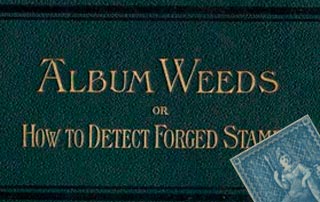
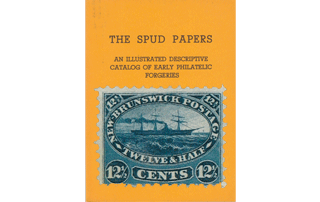
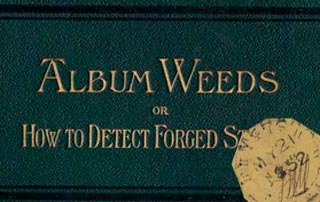
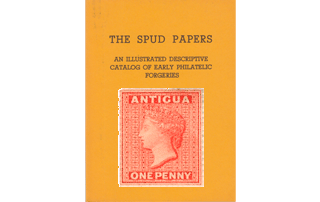
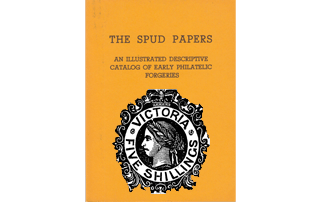
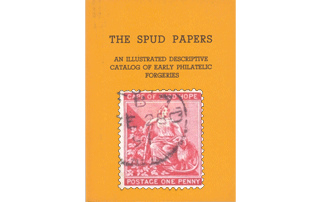

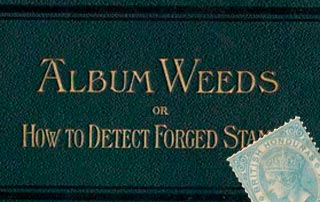
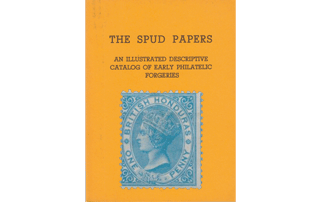
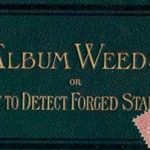
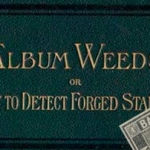
Leave a Reply
Want to join the discussion?Feel free to contribute!